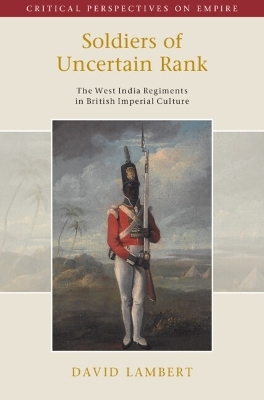
Soldiers of Uncertain Rank
The West India Regiments in British Imperial Culture
Seiten
2024
Cambridge University Press (Verlag)
978-1-009-46441-3 (ISBN)
Cambridge University Press (Verlag)
978-1-009-46441-3 (ISBN)
This book examines the place and status of the Black soldiers of the British Army's West India Regiments from the late eighteenth century until their disbandment in 1927. Analysing their depiction in word and image, it sheds important new light on debates about race, Britishness and military service.
The West India Regiments were an anomalous presence in the British Army. Raised in the late eighteenth-century Caribbean in an act of military desperation, their rank-and-file were overwhelmingly men of African descent, initially enslaved. As such, the regiments held a unique but ambiguous place in the British Army and British Empire until their disbandment in 1927. Soldiers of Uncertain Rank brings together the approaches of cultural, imperial and military history in new and illuminating ways to show how the image of these regiments really mattered. This image shaped perceptions in the Caribbean societies in which they were raised and impacted on how they were deployed there and in Africa. By examining the visual and textual representation of these soldiers, this book uncovers a complex, under-explored and illuminating figure that sat at the intersection of nineteenth-century debates about slavery and freedom; racial difference; Britishness; savagery and civilisation; military service and heroism.
The West India Regiments were an anomalous presence in the British Army. Raised in the late eighteenth-century Caribbean in an act of military desperation, their rank-and-file were overwhelmingly men of African descent, initially enslaved. As such, the regiments held a unique but ambiguous place in the British Army and British Empire until their disbandment in 1927. Soldiers of Uncertain Rank brings together the approaches of cultural, imperial and military history in new and illuminating ways to show how the image of these regiments really mattered. This image shaped perceptions in the Caribbean societies in which they were raised and impacted on how they were deployed there and in Africa. By examining the visual and textual representation of these soldiers, this book uncovers a complex, under-explored and illuminating figure that sat at the intersection of nineteenth-century debates about slavery and freedom; racial difference; Britishness; savagery and civilisation; military service and heroism.
David Lambert is Professor of Caribbean History at the University of Warwick. He is author of Mastering the Niger (2013) and White Creole Culture (2005).
List of Figures; Acknowledgements; List of Abbreviations; 1. Race, Military Spectacle and the West India Regiments; 2. The Spectre of a Black Soldiery; 3. Establishing the Steady Black Soldier; 4. The Reorientation of the West India Regiments; 5. Displaying Valour: Samuel Hodge, VC; 6. Neither Soldiers nor Warriors; 7. Bringing the Troops Home; 8. Remembering the West India Regiments; Bibliography; Index.
| Erscheinungsdatum | 23.08.2024 |
|---|---|
| Reihe/Serie | Critical Perspectives on Empire |
| Zusatzinfo | Worked examples or Exercises; 24 Halftones, color; 15 Halftones, black and white |
| Verlagsort | Cambridge |
| Sprache | englisch |
| Maße | 160 x 235 mm |
| Gewicht | 520 g |
| Themenwelt | Geschichte ► Teilgebiete der Geschichte ► Militärgeschichte |
| Geschichte ► Teilgebiete der Geschichte ► Wirtschaftsgeschichte | |
| ISBN-10 | 1-009-46441-8 / 1009464418 |
| ISBN-13 | 978-1-009-46441-3 / 9781009464413 |
| Zustand | Neuware |
| Informationen gemäß Produktsicherheitsverordnung (GPSR) | |
| Haben Sie eine Frage zum Produkt? |
Mehr entdecken
aus dem Bereich
aus dem Bereich
neueste Manipulationstechniken als Waffengattung der NATO
Buch | Softcover (2023)
Westend (Verlag)
24,00 €


